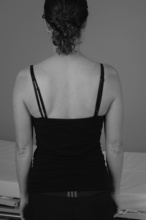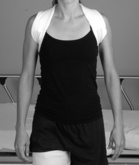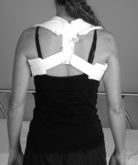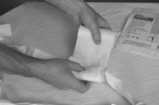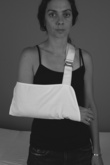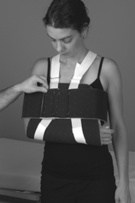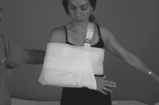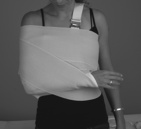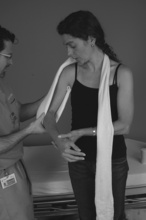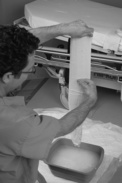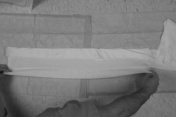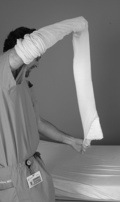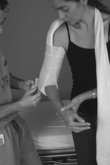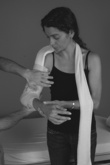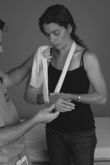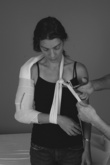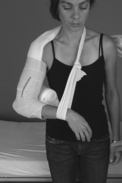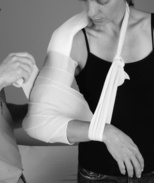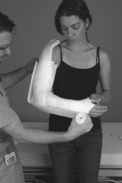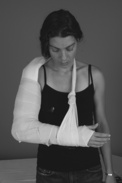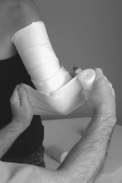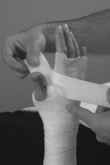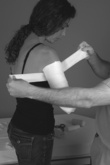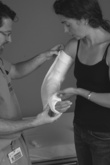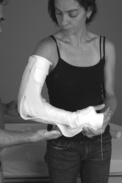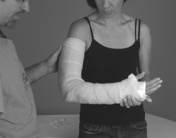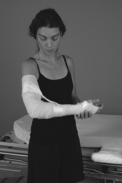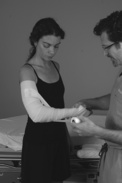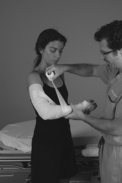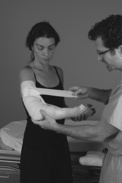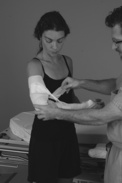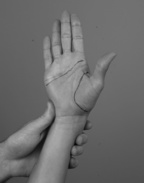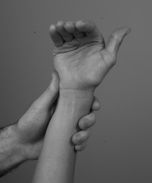Chapter 13 Upper Extremity Splints and Casts
Figure-of-8 splint
Overview
2. Figure-of-8 splints are commercially prepared devices intended to create a reduction force on the clavicle.
Pearls
2. Clavicle fractures with more than 1.5 cm of overlap result in long-term disability and should be treated with an open reduction and internal fixation.
Arm sling/arm sling and swath
Precautions
1. Ensure a proper fit to prevent pressure complications at the back of the neck. It is recommended that a well-padded sling be used or that the neck be padded with cast padding and/or an ABD pad.
Pearls
1. The adult elbow does not tolerate immobilization well. If possible given the nature of the injury, the patient should be instructed to perform daily elbow, wrist, and hand range-of-motion exercises.
Detailed Technique
1. Sling:
b. Pad the neck strap of the sling to prevent pressure complications at the back of the neck (Figures 13-5 and 13-6).
2. Sling and swath:
c. Place talcum powder on the ABD pad and fold the pad in half, with the talcum side facing out (Figure 13-8).
e. Apply the sling and adjust the straps so it is loose while providing some support for the weight of the arm.
g. If using a sling only, swath the arm to the body using cast padding (Figure 13-10) followed by application of a large elastic bandage (Figure 13-11).
Coaptation splint
Overview
1. The correct application of either of the methods described below will ensure that the coaptation splint remains secure and does not fall out of place.
Precautions
1. Do not allow one end of the coaptation splint to end at the fracture site; otherwise, the splint terminus will become a fulcrum and cause more displacement.
Pearls
2. The key to applying a coaptation splint properly is to ensure that the splint always comes above the arm onto the shoulder (Figure 13-12).
3. Use a technique that allows the coaptation splint to be secured around the body to prevent distal displacement. An extra-long elastic or self-adherent bandage is a useful adjunct for a coaptation splint.
4. When applying the splint, have the patient turn his or her head to the contralateral side, which prevents the neck from pushing down the splint during application.
5. We prefer using a self-adhesive bandage to overwrap the plaster because it acts predictably during application, stays in place well, and looks better than other options.
Detailed Technique
1. Measure the length of the splint.
b. Hold one hand in the axilla and wrap the plaster around the elbow until the base of the neck is reached.
6. Prepare the plaster in the usual fashion (Figures 13-16 and 13-17). Use the usual technique of wetting and laminating, followed by placement in cast padding (see Chapter 12).
8. Apply the splint (see Figure 13-12).
a. Start in the axilla or at an appropriate starting point given the fracture site. Provisionally secure it with cast padding at the middle arm.
b. Loop the splint around the elbow. Again, provisionally secure it with cast padding at the middle arm.
10. Apply the mold. Most fractures require a two-point mold, with one hand anterolateral at the fracture site and the other posteromedial at the elbow (Figure 13-20).
12. Place a cast padding wedge under the arm to counteract varus displacement of the fracture (optional) (Figures 13-23 and 13-24).
13. A posterior slab may be added to control elbow motion for more distal fractures (Figures 13-25 and 13-26).
Posterior elbow splint
Overview
1. A posterior elbow splint is inherently weak. Struts must be added to prevent elbow extension in the splint.
Precautions
1. The wrist is usually immobilized to control for pronation and supination about the elbow. Elbow dislocations should be splinted in at least 90 degrees of flexion with the wrist in pronation.
2. Ensure that the splint remains proximal to the palmar flexion crease to preserve complete finger range of motion.
3. At the antecubital fossa, do not allow edges of cast padding to lay immediately within the fossa borders.
a. Allowing edges of cast padding to lay immediately within the fossa borders will create wrinkling and can lead to skin breakdown in this very fragile area.
b. Span the fossa by having the mid point of the cast padding roll directly over the elbow flexion crease.
Pearls
1. A posterior elbow slab is very weak and does not provide significant immobilization.
Detailed Technique
4. Wrap the extremity in cast padding.
b. Circumferentially wrap with cast padding, using a standard 50% overlap technique (see Chapter 12). Two layers of wrapping are sufficient.
c. Carefully tear the cast padding so it conforms around the thumb interspace. Do not go past the palmar flexion crease.
5. Create three cast padding cuffs (see Chapter 12):
a. Palmar flexion crease/metacarpal heads (Figure 13-29): This cuff should form a “V” at the ulnar aspect of the hand to allow for the cascade of the digits.
7. Apply the plaster.
a. Apply the posterior slab first (Figure 13-32).
(1) Position the posterior slab over the ulnar border of the forearm, around the olecranon and the posterior aspect of the arm.
8. Cover the plaster. Wrap cast padding over the top of the plaster to prevent adhesion of the plaster to the elastic or self-adherent bandage (Figure 13-34).
11. Create an external strut (if no internal struts are used) after the plaster has set (Figure 13-36). Use the figure-of-8 technique with tape.
a. Take 2-inch silk tape and begin at the mid point of the posterior aspect of the arm (Figure 13-37)
Long arm cast
Precautions
2. Do not extend the plaster beyond the palmar crease. The patient must be able to flex his or her metacarpophalangeal (MCP) joints to at least 70 degrees (Figure 13-42).
3. At the antecubital fossa, do not allow edges of cast padding to lay immediately within the fossa borders.
a. Allowing edges of cast padding to lay immediately within the fossa borders will create wrinkling and can lead to skin breakdown in this very fragile area.
b. Span the fossa by having the mid point of the cast padding roll directly over the elbow flexion crease.
4. Because the olecranon and ulnar styloid are at risk in this splint, care should be taken to apply additional padding over these areas.
5. Be prepared to bivalve the cast to prevent compartment syndrome if postreduction swelling occurs.
Pearls
4. It is difficult to control elbow flexion and forearm pronation when placing a long arm cast, especially in a child.
a. To partially alleviate this difficulty, it is useful to have older children pretend they are a “drama queen” and have them place the dorsal aspect of their hand on their forehead after the short arm cast has been applied (Figure 13-43).
Basic Technique
1. Patient positioning:
b. Upright: Use a bedside table to allow the patient to place his or her arm at a comfortable level if no reduction is required.
Detailed Technique
2. Position the stockinette:
b. Cut a thumb hole in the mid portion of the other stockinette and fit this piece over the hand (Figure 13-44).
3. Wrap the extremity in cast padding.
b. Carefully tear the cast padding so as to conform around the thumb interspace (Figure 13-46). Do not go past the palmar flexion crease.
c. Once the hand has been adequately padded, continue wrapping proximally to the proximal forearm (Figure 13-47).
d. Span the fossa with cast padding at the antebrachial fossa (Figure 13-48) (see aforementioned precautions).
4. Create three cast padding cuffs (see Chapter 12).




a. Palmar flexion crease/metacarpal heads (see Figure 13-29): This cuff should form a “V” at the ulnar aspect of the hand to allow for the cascade of the digits.
Stay updated, free articles. Join our Telegram channel

Full access? Get Clinical Tree


